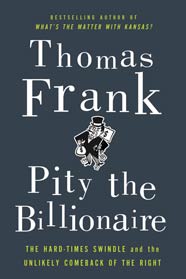
Thomas Frank’s Pity the Billionaire: The Hard Times Swindle and the Unlikely Comeback of the Right is the first full exploration of the rise of a new kind of false populism in the aftermath of our nation’s financial crisis. Like Frank’s best-selling What’s the Matter with Kansas and his Easy Chair columns for Harper’s Magazine, Pity the Billionaire grounds lively first-hand reporting with deep historical insight. Harper’s put six questions to Frank about his writing and the book:
1. Pity the Billionaire chronicles the revival of economic conservatism in the wake of the financial collapse. You term the means of this rise the “hard-times swindle”—the confounding story of a disaster caused by the freest of free-market capitalism, and the subsequent rise of a protest movement clamoring for more. How did Republicans channel the Tea Party’s outrage about economic issues into political power? Which is to say: Why did the swindle work?
First of all, it worked by muddling the story of the housing bubble and the economic collapse, shifting the blame from the real culprits—the much-deregulated financial industry—to those greedy neighbors of yours, buying too much house; or to the liberal state, which according to myth forced banks to hand out bad loans to poor people; or to society generally for tolerating debt at every level.
Secondly, the movement succeeded by capturing completely the one part of the story that was very clear: the bank bailouts, which instantly eclipsed the financial crisis proper when they happened and which immediately got people out of their armchairs sputtering with rage. The bailouts were not confusing. They were very clearly the deed of the federal government, apparently being operated by cronies of Wall Street. It was a spectacle of almost unbelievable corruption, the kind of thing that crushes the faith of a nation. What the public craved at that moment was a form of idealism that would allow us to scream a convincing “no” at the whole thing, and the free-market people—spotting the opportunity like any good entrepreneur—immediately stepped in and delivered exactly such an idealism. (Because, in a pure free-market system, they said, government would never rescue or bail out anyone. The market would decide who prospered and who failed.)
And thus, in miniature, was the complete failure of our great financial free-market experiment transformed into a protest movement demanding that we embrace the free-market system.
2. You vividly evoke the frothy “good versus evil” apocalyptic mania of Tea Party rallies throughout the book—I particularly liked your description of a March 2010 event that featured Jon Voight praying for our legislators’ souls. Did you find anything at those rallies that you didn’t necessarily expect to find? What most surprised you about the tea people?
They were a lot nicer than I expected them to be. The rhetoric you hear from them—all the boastful talk about guns and the outrageous protest signs they love to wave—is all so sanguinary and so apocalyptic that you expect them to be personally a little bit menacing. But they aren’t—quite the opposite: they’re friendly and polite. (At least, that was the case in my experience.) It’s as though they regard what’s being said from the podium and on the placards as a form of entertainment. Even the people selling the boastful or threatening Tea Party trinkets—and there are a lot of these—are just doing their job, getting through the day with a smile.
From Pity the Billionaire:
[T]hrough it all the [Tea Party] protesters’ sense of the injuries suffered by average Americans stayed fresh; their anger at the elites did not dim. They cursed the high and the mighty using the unmistakable terms of the democratic tradition: quoting Jefferson, quoting Franklin, quoting Tom Paine. The zeal of some was so great that they waved “Don’t Tread on Me” rattlesnake flags and wore powdered wigs.
Theirs was a different populism than the one we started with, however. In the early months of 2009, it was mass public outrage against bankers that threatened to pull Americans out of their chairs and into the streets. By the time a year had elapsed, however, the bonus boys’ misbehavior had been pretty much forgotten. In no time at all, the public’s rage had migrated from Wall Street to Washington. Before long the only populism available in the land was an uprising against government and taxes and federal directives—in other words, it was now a movement in favor of the very conditions that had allowed Wall Street to loot the world.
3. At one point, you describe a 2009 Labor Day rally in West Virginia, where thousands applauded the CEO of Massey Energy for his denunciation of government meddling. Eight months later, twenty-nine people died in a tragic explosion at a Massey coal mine, the direct result of the company’s egregious flouting of safety standards. This was only the most vivid example in Pity the Billionaire of a uniquely American paradox, in which working-class people make political decisions that seem to be in direct opposition to their own interests. What drives you to write about this dynamic?
I am drawn to moments of paradox and irony. From my first book about the counterculture’s weird symbiosis with Madison Avenue right down to that rally in West Virginia, this is what I am about. But if you asked me why this is so (and I guess you are asking me), I would have to answer that it’s because we live in paradoxical and ironic times. The social contract of the prosperous and roughly democratic America I was born into has been coming apart for decades, but not for any straightforward reason like “it didn’t work.” It’s coming apart because certain people want it to come apart; because they stand to gain if it comes apart; and yet for them to pull it apart they have to have our consent. And that spells I-R-O-N-Y.
4. In your work, you’ve highlighted politicians’ unending praise song for small businesses, whose proprietors are cast as America’s ultimate job creators—noble, unsung heroes under dire threat from government intervention. How does this fit in with the hard-times swindle?
Small business, it occurred to me, was the real cradle of the Tea Party movement; that’s who these protesters were, that’s how they identified themselves. And small business carries with it a form of populism—I call it “market populism”—that seems on the surface to be every bit as attractive as your traditional workerist populism. Like the original, it pits hard-working average people against parasitic elites (who supposedly get their way via some kind of conspiracy of the educated or via government connections). It imagines that markets are a naturally occurring form of democracy, in which the job-creating entrepreneur is equivalent to the individual citizen, and the countless small enterprises and family-run stores that populate our main streets are the great physical expression of who we are as a nation.
This can be a very attractive worldview in times like ours, especially given the almost complete absence (on the national level, anyway) of a traditional Thirties-style workerist populism. However, the practical effect of the free-market idealism of small-business is to bolster the power of big business. That’s the real beneficiary of small-business’s long war on organized labor and its endless campaigns to slash “red tape” and get government off our backs.
5. Many commentators have drawn comparisons between the Tea Party and union activism in Wisconsin, which you’ve identified in your 2011 Easy Chair columns as the true successor to the working-class populism of the 1930s. Having reported first-hand on both of these phenomena, to what extent do you think the comparisons are accurate? What about comparisons between the Tea Party and Occupy Wall Street?
Well, they’re both a response to the epic cronyism between Wall Street and Washington, and they’re both fond of those Guy Fawkes masks. When I was in Wisconsin reporting on the anti–Scott Walker protests, I also heard very Tea Partyish calls to bring America back to its roots, a familiar phrase by which the protesters meant something very different than what the Tea Party means: a social arrangement by which working people lived middle-class lives. Most importantly, though, they share a very general critique of the government–industry nexus that is similar to the one I described in The Wrecking Crew. With the tea people, however, that vision is always turned inside out. Instead of industry capturing government, it’s always the opposite: government treading industry under its iron heel.

6. Since the crash, economic issues have remained at the forefront of the national conversation. On one hand we’re seeing momentum around new taxes on the wealthy, like the “Paying a Fair Share Act” proposed in Congress last month, while in the Republican primary South Carolina voters seemed to respond to Newt Gingrich’s criticisms of Romney-style venture capitalism. What can we expect from the discussion around economic policy this election year?
From the Republican politicians, I think, we will hear the message they’ve been sharpening for the past three years: that free markets are the beau ideal of human civilization; that they are the incarnation of liberty itself, the dream of the Founding Fathers, and the great guarantee against corruption and tyranny. But more importantly, we will hear all this stuff spoken with a distinctly populist edge to it. Markets let average people choose for themselves; “elites” who think they know better than everyone else (“What a snob!”) want to control and limit your market freedom. Up till now, we’ve heard this mainly from Gingrich, Rick Santorum, and Ron Paul, but Mitt Romney will have to learn to do it too if he wants to be competitive this fall.


